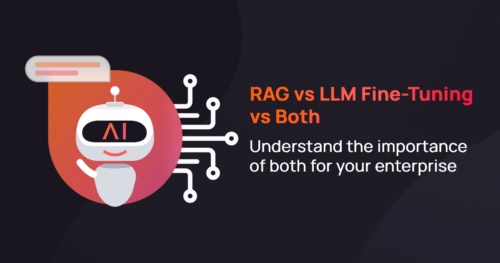An Introduction to RAG and Fine Tuning LLMs
Artificial Intelligence (AI) has significantly advanced, marked by the development of Retrieval Augmented Generation (RAG) and Large Language Models (LLMs) Fine-Tuning techniques. Regardless of their shared goal of enhancing AI’s response to complex queries, they are founded on distinct principles.
RAG in LLM applications can integrate external data for enriched responses, utilizing diverse data sources to enhance the depth and relevance of information retrieval. In comparison, LLM fine-tuning adjusts pre-trained models for domain-specific accuracy. This introduction outlines their roles in refining Agentic AI adaptability and precision, especially in industry-specific LLM applications.
RAG stands for Retrieval Augmented Generation and on the other hand, fine-tuning LLM stands for Large Language Model fine-tuning. Both of them fall under the wider range of AI approaches geared to improve how a trained language model AI model responds to user inputs. The aim is to increase the models’ understanding of complex user requests, improve their relevance, and personalize their generated responses.
These models are built on a transformer architecture, typically pre-trained on large and diverse datasets. This pre-training helps develop a broad understanding of language structure, context, and semantics.
How Does LLM Fine-tuning Work Compared to RAG systems
Fine-tuning involves adjusting pre-trained Language models (LLMs) using a specific dataset to adapt the model’s behavior or performance to a particular task or domain. This process, combined with prompt engineering, allows the model to learn domain-specific nuances, enhancing its accuracy and relevance for specialized applications. During this phase, slight adjustments are made to the model’s internal parameters (weights) to reduce the AI hallucination and error in predictions in the new, specific context.
The learning rate during fine-tuning is usually lower than in pre-training to prevent drastic changes that could erase the general language understanding acquired during the initial training phase. Typically, only a subset of the model’s internal weights is adjusted, which requires substantial computational resources to manage efficiently.
For instance, consider the case of leveraging a large language model in the healthcare domain. A general large language model might have a basic understanding of medical terminology but might not have a detailed grasp of disease classifications, treatment protocols, drug interactions, etc. When we perform LLM fine-tuning with healthcare-specific datasets, the large language model can learn these specific terminologies.
For example, when the phrase “MI” is input, a foundational model might not understand that in the healthcare field, this often refers to “Myocardial Infarction”, also known as a heart attack. However, healthcare fine-tuned large language models would understand this reference and could provide information or support a conversation about diagnosis, treatment, risk factors, etc.
LLM fine-tuning requires the model to gain a deeper understanding of the language nuances and mannerisms that are unique to the context. It transforms the general model into a tailored conversationalist able to handle user queries relative to a specific domain or task with high precision.
How Does RAG Work and Why Is It Important?
On the other hand, RAG (Retrieval Augmented Generation) combines aspects of retrieval-based systems and generative models. The RAG model recognizes that no matter how comprehensive the training data is for a general LLM, there’s always potential for missing data elements that could contribute to answering new, complex questions.
This is particularly relevant when new public external knowledge emerges after the model has been trained, or when proprietary enterprise information (which is naturally private and therefore not included in the general model training) is needed to provide an answer. To overcome this, RAG fetches relevant information from a more relevant document set in real time and incorporates it into its responses.
With RAG, a higher level of context-specific insight and understanding is achieved. The RAG model acts as the instant expert that evolves a general large language model into a specialized one, capable of retrieving and utilizing dynamic data to generate responses, even to queries that require an external knowledge base beyond its initial training data

Supercharge LLM Performance with RAG and LLM Fine-Tuning
To illustrate the benefits of combining RAG with LLM Fine-Tuning, let’s consider the case of a Generative AI Assistant trained to answer questions related to the healthcare domain, improving its question-answering capabilities. Let’s consider the following user question as an example: “What’s the effect of drug X on my hypertension and diabetes?”
An LLM fine-tuned with a medical knowledge base understands that “hypertension” and “diabetes” are chronic diseases, and “drug X” is a medicinal variable that can have an impact on these. The fine-tuning LLM can produce answers like “drug X is commonly prescribed for condition Y, which is unrelated to hypertension and diabetes.” This specificity of contextual perception demonstrates the advantage of a fine-tuned LLM.
The user query also implicitly seeks information about potential interactions between drug X and their existing hypertensive and diabetic medications, a complex question that demands extensive retrieval of healthcare data. Even with the best LLM strategy, this task can exceed a fine-tuned LLM’s capacity, underscoring a limitation of this model. However, RAG systems excel by leveraging vast vector databases of healthcare information to fetch and incorporate the necessary details into their responses.
The RAG approach leverages a vast vector database of healthcare information that includes details regarding drug interactions. For the same user query, the RAG might extract relevant information about “drug X”’s pharmacodynamics, its potential effect on diabetes and hypertension, and any known interactions with other medicines.
However, the RAG model could potentially face limitations when the query involves specialized terms or abbreviations common in healthcare. If “drug X” was a specific medical term unfamiliar to the system, the answer generation might be compromised, showing a limitation in its ability to decode highly specific medical abbreviations.
By marrying the benefits of improving LLM performance with fine-tuned LLM and RAG, a holistic approach emerges that could address the user query more comprehensively. The fine-tuned LLM component recognizes “drug X”, hypertension, and diabetes plus their related terminologies or abbreviations and anchors the context accordingly.
Meanwhile, the RAG model retrieves relevant information about “drug X”, its effects on hypertension and diabetes, and any contraindications for patients with these medical conditions, providing a detailed, nuanced response to the user’s request.
Combining both models effectively navigates the sophisticated interplay between specialized medical vocabulary and the need for in-depth healthcare information retrieval. This enhanced UX better addresses the complexity and unique requirements of healthcare domain inquiries.
Incorporating LLM Embeddings
LLM embeddings are a crucial part of the fine-tuning process. They capture the semantic meaning of words and phrases in the context of the domain-specific corpus, enabling the model to understand and respond to queries more accurately. These embedding models, fine-tuned with healthcare-specific data, help the LLM distinguish between terms that might have different meanings in different contexts.
For example, “MI” embedding would be aligned with “Myocardial Infarction” in the healthcare context. This deep semantic understanding, powered by LLM embeddings, further enhances the model’s ability to provide precise and contextually relevant responses.
LLM fine-tuning or RAG or Better together!
In conclusion, both the Retrieval-Augmented Generation (RAG) and LLM Fine-Tuning models hold significant potential within specific domains and industries. They are well-equipped to handle complex user queries and can personalize responses based on context and domain-specific nuances.
By combining the benefits of the RAG’s ability to retrieve relevant information in real-time and the large language model fine-tuning’s deeper understanding of language peculiarities of the context, an AI Copilot can provide users with precise and comprehensive responses to their inquiries.
Implementation of such a combination can prove to be extremely effective as a tool for providing a better user experience and effectively addressing the complexity and unique requirements of industry-specific inquiries.
This approach allows for surpassing individual limitations of the respective models, offering expertise in situations demanding extensive retrieval of specific data or understanding of specialized terms. Book an AI demo and explore Aisera’s Enterprise LLM for your organization today!

